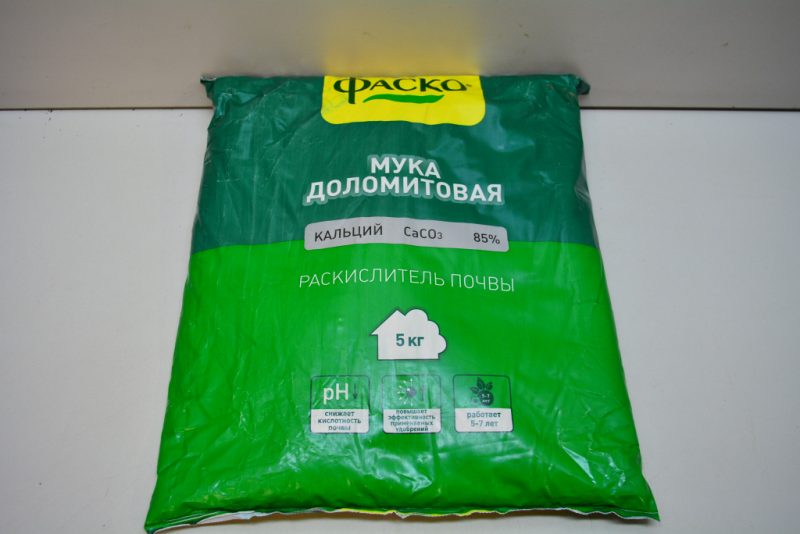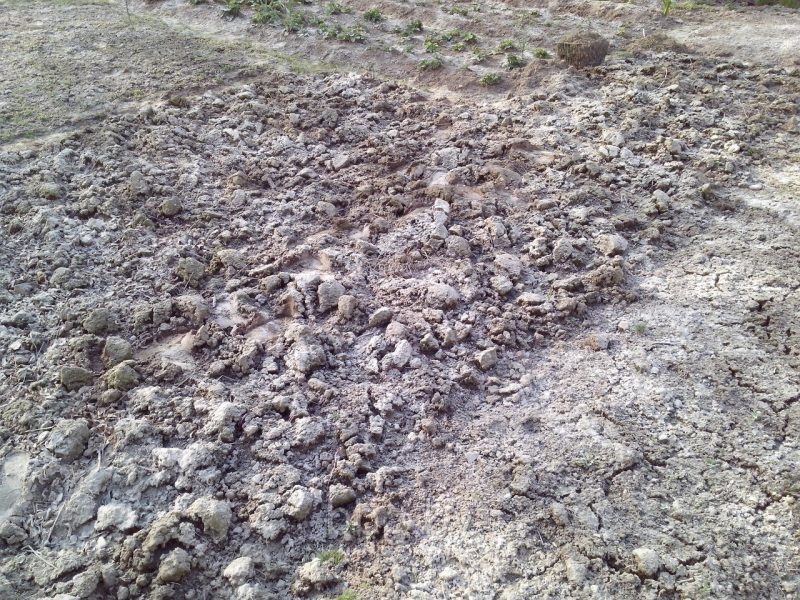Dolomite is a carbonate rock, which is a complex of calcium and magnesium, and the so-called "dolomite flour" is crushed dolomite. In plant growing, this mineral is widely used. Knowing what dolomite flour is, how to use this product in the garden and how to introduce it, you can significantly improve the condition of the soil and increase the yield of plants.
Material Content:
Why do we need dolomite flour in the garden?
Most of the Russian garden plots are located on acidic podzolic soils. Among garden crops, it is difficult to find acidophilic plants that prefer to grow on such soils.

The acid reaction of the environment negatively affects the development of plants:
- nitrogen is poorly absorbed, the plants exhibit symptoms of nitrogen starvation: chlorosis, growth retardation, shredding of leaves and fruits, death of the kidneys;
- phosphorus goes into an unapproachable form, the plants exhibit symptoms of phosphorus starvation: general inhibition, death of the leaves, deterioration or termination of flowering and fruiting;
- beneficial soil flora is inhibited, pathogen activity increases, plants are severely affected by root rot and fungal infections.
With a high level of soil acidity (pH less than 5.5 units), it becomes mandatory to use a deoxidizer, which is dolomite flour. Upon transition to a soil solution, calcium and magnesium carbonates neutralize acids, and make the soil more suitable for crop production.
Speaking about why dolomite flour is needed in the garden, it is worth noting the important role of calcium in fertility.Analysis of various types of soil shows that the less soil contains this element, the lower the fertility:
| Soil type | The content of calcium carbonate (CaCO3),% | The content of absorbed calcium per 100 g of soil, mg |
|---|---|---|
| Black earth | 0,2-14 | 21-50 |
| Chestnut soil | 0,6-8,8 | 20-25 |
| Gray earth | 10-22 | 8-21 |
| Gray forest soil | 0 | 6-36 |
| Podzolic soil | 0 | 2-12 |
This dependence is explained by the fact that calcium ions help the formation of soil colloids, due to which the porosity increases and the soil structure improves.
What plants are good for?
Almost all garden crops will respond well to the introduction of dolomite flour.

Its use is especially useful when growing the following plants:
- all kinds of cabbage;
- radish, turnip, daikon;
- beets and chard;
- green crops: dill, parsley, celery, cilantro, salads, mustard;
- onions: onions, leeks, slime, batun, shallots, chives, garlic;
- carrot;
- potatoes and eggplant;
- pepper;
- garden strawberry;
- pumpkin crops: cucumbers, zucchini, pumpkins, squash;
- gourds: watermelons and melons;
- legumes: peas, beans, beans.
Tomatoes are more tolerant of increased pH, but the application of dolomite flour will also have a favorable effect on their productivity. Under acidophilic fruit and ornamental crops (blueberries, sorrel, cranberries, gooseberries, rhododendrons) the soil does not deoxidize.
How to use?
Before using dolomite flour, it is necessary to determine the acidity and particle size distribution of the soil. The application rate directly depends on this:
| soil pH | Grading | The rate of application of dolomite flour per 1 m2 |
|---|---|---|
| 5,0-5,5 | Medium and light loam | 300 grams |
| Heavy loam, clay, peat or silty soil | 350 grams | |
| Sandy loam or sandy soil | 250 grams | |
| 4,5-5,0 | Medium and light loam | 400 grams |
| Heavy loam, clay, peat or silty soil | 450 grams | |
| Sandy loam or sandy soil | 350 grams | |
| Below 4.5 | Medium and light loam | 500 grams |
| Heavy loam, clay, peat or silty soil | 550 grams | |
| Sandy loam or sandy soil | 450 grams |
If the pH of the soil is from 6.0 or higher, it is not recommended to use dolomite flour.
The introduction of dolomite flour
Dolomite flour can be applied to the soil in four ways:
- Throughout the site. Based on the application rate, flour is scattered on the surface of the site, after which they dig the soil.
- In the garden or near-trunk circle. Based on the application rate, the flour is distributed over the prepared bed and a rake is embedded in the soil. Sealing in the near-stem circle is done by a plane cutter, after which the soil is mulched.
- To the landing hole. When planting seedlings or when planting potatoes, 5 tablespoons of dolomite powder are added to each well, mixed with soil and planted.
To increase the effectiveness of dolomite flour, it is useful to introduce it simultaneously with well-ripened compost, dung or leaf humus. It can not be used simultaneously with mineral fertilizers. If this type of top dressing is preferred, deoxidizer and fertilizer are applied at intervals of at least 1 week.
Fertilizer application time
Most often, dolomite flour is used in autumn or spring soil preparation. In autumn, this is done after harvesting, in the spring - 2-3 weeks before sowing.

You can use dolomite powder in the summer. During this period, it is more convenient to process perennial crops, closing the product in the trunk circles.
The frequency of treatment depends on the properties of the soil. On heavy clays, dolomite flour is used every year. On medium and light soils - 1 time in 3-5 years.
The effect of feeding
The effect of making dolomite flour does not appear immediately. Acidity shifts in a few months; therefore, on highly acidified soils, it is more profitable to till the soil in autumn. Spring and summer applications are carried out on well-cultivated soils in order to maintain optimal acid-base balance.
The systematic and competent use of dolomite flour in the garden leads to the following results:
- noticeable improvement in the physico-chemical characteristics of the soil;
- increased activity of beneficial soil flora;
- reduction in the incidence of plants with fungal and bacterial infections;
- reduction in plant susceptibility to soil pests;
- increasing the power of the root system of plants, the formation of healthy smooth root crops and tubers;
- general increase in crop yields.
The maximum effect develops for 2-3 years after the introduction of dolomite powder and the transition of calcium and magnesium into the soil solution.
How to replace dolomite flour?

In addition to dolomite flour, the following products are used to deoxidize the soil:
| Means | Characteristic | Application Method |
|---|---|---|
| Lime Fluff | It is slaked lime - Ca (OH) 2. It has a more active neutralizing effect than calcium carbonate. Requires a longer interval between tillage and planting. | Deep incorporation into the soil when digging in the autumn, after harvesting. It is used no more than 1 time in 6 years. |
| Wood ash | Deoxidizing properties are milder than dolomite flour. Suitable for slightly acidic soils with a pH of at least 5.5. It is valuable as potash-phosphorus fertilizer with a large additional set of elements - calcium, zinc, sulfur, etc. | Shoveling during spring or autumn tillage. Nesting in wells when planting seedlings or planting potatoes. Summer watering with water solutions. |
| Agromel | A partial analogue of dolomite flour, pure calcium carbonate, without magnesium carbonate. It has the same deoxidizing effect as dolomite powder. | In the spring or in the fall it is closed under a shovel once every 6 years. It is brought in landing holes or in beds, as dolomite flour. It is highly soluble in water and used for summer irrigation. |
Thus, it is possible to replace dolomite flour on strongly acidic soils with either fluff lime or agromel. In areas with a slightly acidic soil reaction, it is more profitable to use wood ash.
Pros and cons of using

Like any other product, dolomite flour has its advantages and disadvantages:
- Advantages - environmental cleanliness and safety, a positive effect on soil flora, high efficiency in deoxidation and increased soil fertility, the possibility of use throughout the season.
- Disadvantage - gradual development of the effect.
Considering the fact that dolomite flour has more advantages than disadvantages, it can be considered an almost ideal way to improve the soil. When using dolomite powder according to the application rate, no negative side effects are observed.












